When it comes to grammar, possessive plural nouns can sometimes be confusing for many people. However, understanding how to properly use possessive plural nouns is essential for effective communication in writing. In this article, we will explore some examples of possessive plural nouns to help clarify any doubts you may have.
Before we delve into examples of possessive plural nouns, it is important to understand what they are. Possessive plural nouns are used to show ownership or possession by more than one person, group, or thing. They are formed by adding an apostrophe and an “s” to the plural form of the noun.
Examples of Possessive Plural Nouns
1. The students’ books were scattered all over the classroom. (The books belong to more than one student.)
2. The dogs’ leashes were tangled together in the park. (The leashes belong to multiple dogs.)
3. The employees’ uniforms were neatly hung in the locker room. (The uniforms belong to the employees of the company.)
4. The children’s toys were strewn across the living room floor. (The toys belong to more than one child.)
5. The teachers’ lounge was a peaceful retreat from the bustling school hallways. (The lounge is designated for the use of multiple teachers.)
As demonstrated in the examples above, possessive plural nouns help clarify who the owner or possessor of a particular item or object is. By adding an apostrophe and an “s” to the plural form of the noun, we can easily indicate possession in a sentence.
In conclusion, possessive plural nouns are an important grammatical concept that can enhance the clarity and effectiveness of your writing. By understanding how to use possessive plural nouns correctly, you can ensure that your writing is clear and concise. So, the next time you encounter a situation where you need to show ownership by more than one person or thing, remember to use possessive plural nouns to convey your message accurately.
